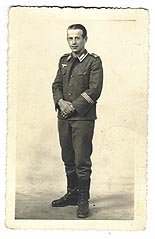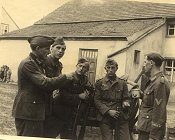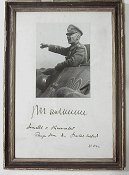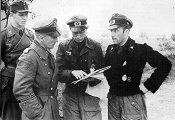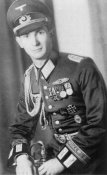
by COL Scott Pritchett
WEAR AND REGULATIONS
Click on image to Enlarge
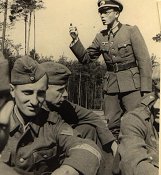 |
A group of soldiers being spoken to by their officer. Note the soldier in the foreground wears the AFRIKA cuffband on his continental style uniform.. |
As an award, the recipient received a single piece, usually cut from a roll of manufactured cuffbands. An award document accompanied the award and with this, the recipient was authorized by regulations to go to any authorized outlet source and obtain additional items. Any member was authorized to obtain privately purchased awards, although by the time in the war that the AFRIKA cuffband was being issued, significant controls were in place to economize on war materials. Officers, who were responsible for their own uniforms, and therefore received a maintenance allowance, were the most frequent users of privately purchased items throughout the war.
The AFRIKA cuffband was correctly worn on the lower left sleeve of the bearer, although photographic evidence attests to the fact that on some occasions this regulation was ignored. Perhaps the most notable example of this practice was General von Manteuffel, who elected to wear his award on his right sleeve along with his Grossdeutschland cufftitle.
|
|
A rare wartime photo of a Kriegsmarine member wearing the authorized AFRIKA cuffband award |
| TheGefreiter on the right in this photo wears the AFRIKA cuffband on his continental combat tunic. He is not wearing any combat badges, but close inspection shows evidence of at least one set of badge loops. |
Correctly positioned as a single award, it was positioned 7-8 cm above the lower edge of the sleeve on the parade waffenrock and 15 cm above the cuff edge of the service, and / combat uniforms. If the uniform had turn back cuffs/French cuffs, such as in the case of the greatcoat or Luftwaffe and Heer officers’ uniforms, the cuffband was correctly positioned 1 cm above the top edge of the turn back. Much is made in collectors’ circles of the significance between machine stitched and hand sewn attachment of insignia. It remains difficult to make a case that machine sewing versus hand sewing, or visa-versa, is an indication of an originally war time applied cufftitle. Both methods were used and both are, therefore, correct. Likewise, it is difficult to state categorically that any particular style of uniform always had cufftitles attached in this or that way. Photographic evidence and examples of uniforms and cufftitles in private collections adequately attest to these points. However, hand sewing of sleevebands was the more common method and made more sense given the practices of the times. Ultimately, with the availability of period original threads to the collector, it is often near impossible to tell if the sleeveband is true to the uniform without obvious wear and tear indications. One should never attempt to remove an original sleeveband from a uniform to look for differences in the wear of the nap, as there is a 50% chance that you are likely to have made a mistake and altered a piece of history.
If the AFRIKA cuffband was worn in conjunction with other sleevebands, the oldest award had precedence and therefore was worn highest on the sleeve. Notice from the von Manteuffel photos below, the general at least wore his AFRIKA cuffband correctly placed above his Großdeutschland cufftitle. The additional photo is an example of multiple awards being worn correctly - in this case by a Luftwaffe member.
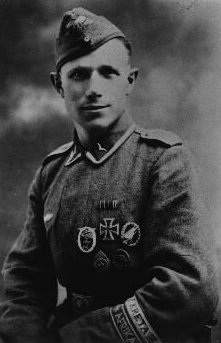 |
Portrait photo of a well decorated Luftwaffe Fallshirmjäger NCO who was awarded both the KRETA and AFRIKA cuffbands. He has these positioned correctly with the oldest title at the top. Note both the Luftwaffe Paratrooper and the Luftwaffe Ground Combat Badges in wear. |
|
Click on image to Enlarge |
Original wartime presentation photo with inscription of Generalleutnant von Manteuffel while he was commanding Panzergrenadier Division Großdeutschland. Of interest is the fact that he elected to wear his AFRIKA band on his right sleeve - the location the Heer reserved for unit cufftitles. Generalmajor von Manteuffel served in Africa from the beginning of 1943, assuming command of 'Division von Broich' in February, which was redesignated 'Division von Manteuffel' at that time. The division fought in until surrender on 9 May 1943, but von Manteuffel was only in command through March 1943. . |
|
Click on image to Enlarge |
General der Panzerrtruppe Hasso von Manteuffel in an orders group with members of the 116th Panzer Division, while he was commanding the 5th Panzerarmee. This moment in time would have been captured during preparation for Wacht am Rhein - what became to be for the Allies the Battle of the Bulge in Allied terminology. Von Manteuffel wears a leather overcoat with the AFRIKA cuffband being worn on the incorrect arm. The Großdeutschland cufftitle is also worn - on the correct arm - and in this case, above the AFRIKA band, attesting to the stature von Manteuffel accorded his service in command of this elite unit. Although no longer commanding Panzergrenadier Division Großdeutschland at the time of this photo, it is known that the GD unit cufftitle was permanently awarded within the division on rare and exceptional occasions for superior service. In fact it was von Manteuffel who began this practice as division commander. The Division even created divisional award documents to support the permanent awarding of the cufftitle, which otherwise had to be removed if the soldier was reassigned. It is likely that von Manteuffel received such an honor upon hid departure as the GD's commanding general. However, as worn by von Manteuffel, this combination is otherwise entirely incorrect. He is also known to have continued to wear the unique GD cipher on his shoulder straps after taking command of 5th Panzerarmee. |
|
Click on image to Enlarge |
A rare picture in two respects. First, it shows the AFRIKA band worn on the Heer parade Waffenrock. By this time in the war, Waffenrocks were no longer authorized to for manufacture, although they could still be worn. Secondly, the soldier is a member of the Heer's elite panzergrenadier division, the Großdeutschland. As this division did not fight in North Africa, he is obviously a late volunteer for this Russian Front workhorse division. |
![]()
© Copyright Wehrmacht-Awards.com LLC |
